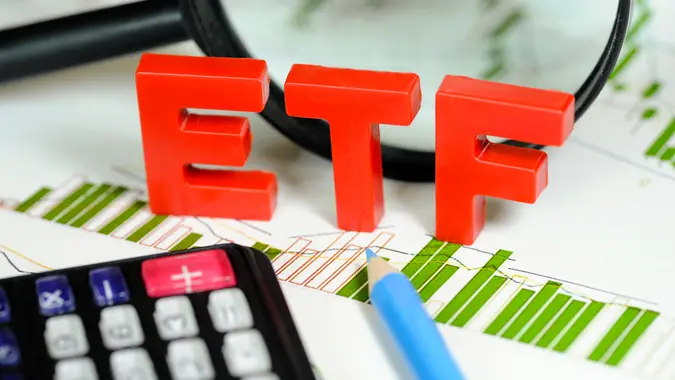Best Fidelity Index Funds for 2025

Commitment to Our Readers
GOBankingRates' editorial team is committed to bringing you unbiased reviews and information. We use data-driven methodologies to evaluate financial products and services - our reviews and ratings are not influenced by advertisers. You can read more about our editorial guidelines and our products and services review methodology.

20 Years
Helping You Live Richer

Reviewed
by Experts

Trusted by
Millions of Readers
Fidelity index funds provide investors with a simple, low-cost method of diversifying their portfolios across several market sectors. An index fund aims to track the returns of a stock market index, such as the S&P 500 or Russell 2000. Index funds can take different forms, including mutual funds and ETFs. An index fund might buy all of the securities that comprise an index or just a representative sample.
Some investors pick a few stocks and hope for a couple of big winners, but the index fund investor buys and holds a wide range of securities, hoping to ride the wave of long-term market growth. This makes index funds more stable and better suited for retirement investments. Just keep in mind that, as with any investment, the money you put into an index fund is always at risk of losing value.
Best Fidelity Index Funds in 2025
Although many investors are familiar with S&P 500 index funds, there are actually many different types of index funds. Here are some of the best that Fidelity offers:
- Fidelity Multi-Asset Index Fund (FFNOX)
- Fidelity Nasdaq Composite Index Fund (FNCMX)
- Fidelity Large Cap Growth Index Fund (FSPGX)
- Fidelity 500 Index Fund (FXAIX)
- Fidelity Total Market Index Fund (FSKAX)
- Fidelity U.S. Sustainability Index Fund (FITLX)
This evaluation of the top Fidelity index funds to buy looked at several measures of performance. You’ll find the following information associated with each of these Fidelity funds:
- Fund overview
- Average annual returns
- Expense ratio
- Top five holdings
1. Fidelity Multi-Asset Index Fund (FFNOX)
Previously called the Fidelity Four-in-One Index Fund, the Multi-Asset Index Fund invests in seven Fidelity stock and bond index funds, allocating assets to achieve broad diversification. The fund has a 49.44% weighting in domestic equity funds, with an additional 24.80% in developed market equity funds, 10.40% in emerging market equity funds, 7.18% in U.S. investment grade bond funds, 5.10% in long-term U.S. Treasury bond funds, and 3.05% in international bond funds.
- Average annual returns:
- -4.11% year to date
- 0.71% one year
- 10.95% five years
- Expense ratio: 0.11%
- Top five holdings: Fidelity 500 Index Fund, Fidelity International Index Fund, Fidelity U.S. Bond Index Fund, Fidelity Long-Term Treasury Bond Index Fund, Fidelity International Bond Index Fund
2. Fidelity Nasdaq Composite Index Fund (FNCMX)
This fund is designed to closely track the price and yield of the Nasdaq Composite Index. Fidelity normally invests at least 80% of its assets in common stocks included in the index. The fund is heavily skewed toward technology, with 47.81% of the fund in information technology and an additional 15.21% in communication services.
- Average annual returns:
- -13.36% year to date
- 6.47% one year
- 14.91% five years
- Expense ratio: 0.29%
- Top five holdings: Apple, Microsoft, Nvidia, Amazon, Meta
3. Fidelity Large Cap Growth Index Fund (FSPGX)
This fund invests at least 80% of its assets into securities included in the Russell 1000 Growth Index, with a focus on large-cap growth stocks. The fund’s industry weightings closely mirror those of the Russell 1000 Growth Index, with 45.95% in information technology, 14.81% in consumer discretionary stocks, and 12.69% in communication services.
- Average annual returns:
- -13.53% year to date
- 8.16% one year
- 16.48% five years
- Expense ratio: 0.035%
- Top five holdings: Apple, Microsoft, Nvidia, Amazon, Meta
4. Fidelity 500 Index Fund (FXAIX)
The fund’s purpose is to track the returns of the most popular market index, the S&P 500. At least 80% of assets are invested in stocks included in the S&P 500 index.
- Average annual returns:
- -8.92% year to date
- 6.03% one year
- 15.27% five years
- Expense ratio: 0.015%
- Top five holdings: Apple, Microsoft, Nvidia, Amazon, Meta
5. Fidelity Total Market Index Fund (FSKAX)
Managers of this fund aim for investment returns that track the total return of a broad range of domestic equities. With that in mind, they put 80% of the fund’s assets into securities included in the Dow Jones U.S. Total Stock Market Index. The fund has a more diversified composition than some of the tech-heavy funds on this list, with just 28.02% in information technology stocks and 15.17% in financials. Healthcare and consumer discretionary stocks comprise 11.25% and 10.34% of the portfolio, respectively.
- Average annual returns:
- -9.20% year to date
- 5.44% one year
- 14.82% five years
- Expense ratio: 0.015%
- Top five holdings: Apple, Microsoft, Nvidia, Amazon, Meta
6. Fidelity US Sustainability Index Fund (FITLX)
This fund tracks the MSCI USA ESG Index, which targets mid- and large-cap companies with positive environmental, social and governance performance relative to their peers. This makes the fund, and its underlying index, a bit unique in that it could, theoretically, own stocks in any industry and doesn’t follow a specific style classification. As of now, the fund has a large-growth tilt, with 28.82% in information technology, 12.89% in financials, 10.16% in healthcare and 9.63% in consumer discretionary.
- Average annual returns:
- -10.43% year to date
- 2.77% one year
- 14.79% five years
- Expense ratio: 0.11%
- Top five holdings: Nvidia, Microsoft, Alphabet Class A, Alphabet Class C, Tesla Inc
Why Invest in Fidelity Index Funds?
Fidelity index funds feature comparatively low costs, making them well suited to buy-and-hold investors. Fidelity equity funds combine low expenses and good growth potential, with index funds heavily tilted toward technology and consumer discretionary stocks. Bond funds provide a lower-risk option.
Investors looking for index funds that follow U.S. bond indexes and stock indexes of all market cap sizes, international equity markets, emerging markets and even bonds should consider Fidelity. You get a wide range of choices — including sustainable index stock and bond funds — allowing you to construct an asset-allocated portfolio just right for your needs and investment timeline. Some of the best Fidelity index funds even pay dividends.
Fidelity Index Funds vs. Other Investment Options
There are three main alternatives to Fidelity index funds: Fidelity actively managed funds, individual stocks/bonds, or other firms’ funds or ETFs. Each has its pros and cons.
| Investment | Pros | Cons |
| Fidelity index funds | Low costs, transparent holdings | Guaranteed “average” return |
| Individual stocks/bonds | Can potentially provide high returns with no fees at all | Individual investments carry higher risk profiles |
| Other firms’ funds/ETFs | May have broader portfolio options; ETFs can be bought and sold at any time on the open market | May have higher expense ratios and/or lower performance |
Risks of Investing in Fidelity Index Funds
One thing to note with index funds, whether from Fidelity or another brokerage or investment firm, is that you won’t get active management. While the funds are low-cost and do a good job of tracking their underlying indexes, you are guaranteeing yourself an “average” performance, as there aren’t any stock- or bond-picking managers that can add value and potentially outperform. Also, not all of Fidelity’s index funds are ultra-low cost, despite the firm’s overall success in this area.
Beyond that, Fidelity index funds are subject to the same risks as their underlying assets. For example, Fidelity bond index funds are subject to interest rate risk, purchasing power risk, and inflation risk. Fidelity’s equity index funds are subject to market risk, financial risk, legislative ris,k and others, just like their underlying stocks.
Trends Shaping Fidelity Index Funds in 2025
While current market trends or geopolitical concerns may affect individual funds, as a whole, no trend really affects Fidelity index funds. The firm continues to increase its assets based on its reputation for high performance with low costs. While a recession or bear market may draw investors out of their equity funds, much of that money is likely to find a home in a Fidelity bond fund instead.
But if you’re going to invest in a Fidelity index fund, it’s crucial to understand how market factors can indeed affect your investment directly. For example, if you buy an aggressive growth index fund and the market falls into a recession, you should expect your share price to be impacted negatively.
How To Buy Fidelity Index Funds
Here’s a look at the steps you’ll need to take to invest in Fidelity index funds.
- Open a brokerage account: Before you can invest in Fidelity index funds, you’ll need to open a brokerage account. The account doesn’t have to be with Fidelity, but Fidelity offers a collection of zero-expense-ratio index funds that are available only to investors who purchase shares through a Fidelity account.
- Fund your brokerage account: The next step is to fund your account with the money you’ll use to purchase investments. Linking your brokerage account to a bank account is an easy way to do it. Just select that option from your account on the brokerage website and then enter your bank information. You can transfer money into the brokerage account as soon as the broker verifies your bank routing and account numbers.
- Search for Fidelity index funds: Brokerage websites typically have an investment screening feature that lets you search for funds to invest in. On Fidelity’s platform, you select the “News & Research” navigation link and then select “Mutual Funds.” The screener page will have search criteria you can select to narrow the choices. Select Fidelity as the funds provider, and select “Index” as the type of fund management. You can further narrow the results by selecting additional criteria. The search should generate a list of funds that meet your criteria.
- Place your order: With the fund you want to invest in showing on your screen, look for a button that says “Buy” or “Trade.” Selecting that button will take you to an order page. Follow the prompts to place your order.
Daria Uhlig and John Csiszar contributed to the reporting for this article.
Data is accurate as of Apr. 23, 2025, and is subject to change. Data was sourced from Fidelity and Yahoo! Finance.
Editorial Note: This content is not provided by any entity covered in this article. Any opinions, analyses, reviews, ratings or recommendations expressed in this article are those of the author alone and have not been reviewed, approved or otherwise endorsed by any entity named in this article.
 Written by
Written by  Edited by
Edited by 

























